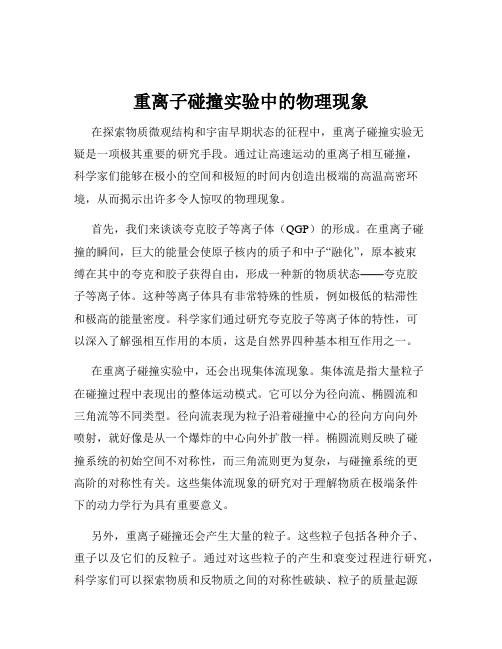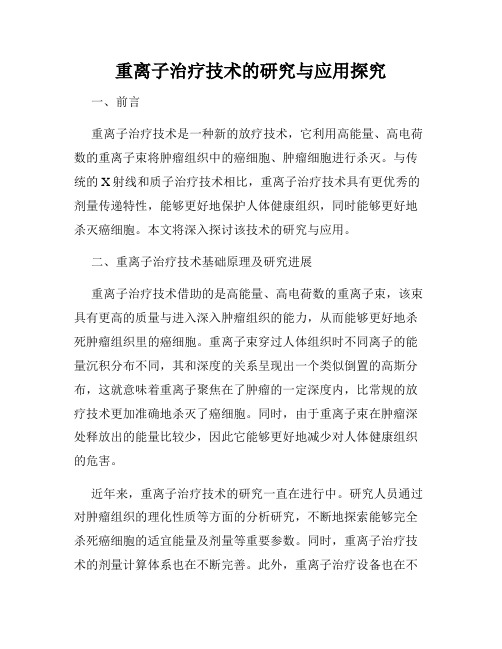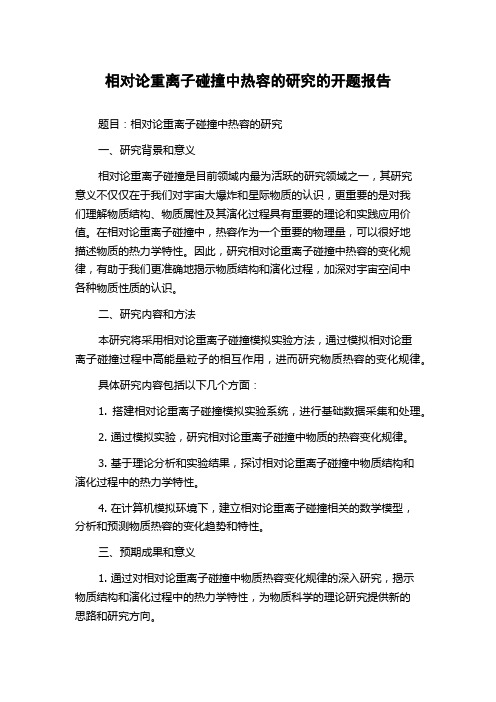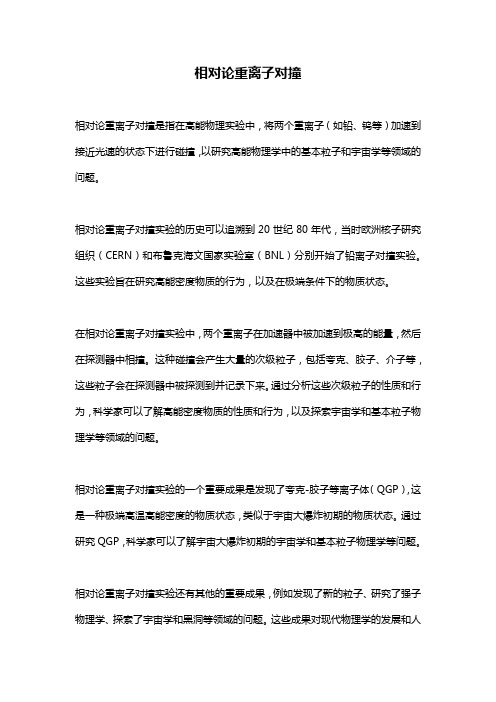相对论重离子碰撞的现状及展望
重离子治疗肿瘤的现状和未来

重离子治疗肿瘤的现状和未来肿瘤是人类健康的重大威胁之一。
传统的治疗方式包括外科手术、放射疗法和化学疗法,但这些治疗手段都存在着一些缺点,如对健康组织的损伤、对肿瘤的治疗效果不一等问题。
随着科技的发展,新的治疗手段也不断涌现出来,其中重离子治疗就是备受关注的一种。
什么是重离子治疗?重离子治疗是一种高精度放疗技术,它采用高能量、高电荷量的重离子来治疗肿瘤。
相比于传统的放射疗法,重离子治疗在选择性杀伤癌细胞和保护健康组织方面更具优势,因此受到了越来越多的关注。
其原理是将重离子束直接瞄准到肿瘤组织中,通过离子与肿瘤细胞之间的相互作用来杀死肿瘤细胞。
离子的作用长度较短,可以避免对周围组织的损伤,达到精准治疗的效果。
重离子治疗的优势1. 精准度高。
重离子束不但可以造成较高的癌细胞杀伤,而且还可以减少肿瘤细胞周围正常细胞的损害,因此对病人的健康和生活质量具有更好的保障。
2. 疗效显著。
由于重离子束可以更好地瞄准到肿瘤组织,因此可以大幅度提高肿瘤细胞的死亡率,从而获得更加显著的治疗效果。
3. 外科手术的替代。
对于一些难以通过手术切除的肿瘤,如位于脑干、脊髓等部位的肿瘤,重离子治疗是一种替代手术的有效方法。
当前重离子治疗面临的挑战1. 费用高昂。
重离子治疗的成本非常高,而且需要昂贵和超高能量的加速器设备及其附属设施,这使得重离子治疗不能广泛普及。
2. 离线时间长。
重离子治疗需要专门的设备来产生和加速离子束,因此离线时间比传统放疗更长,难以满足患者的紧急需求。
3. 疗程慢。
重离子治疗需要多次疗程,每一次治疗的时间比传统放疗更长,因此可能会给患者带来不便。
重离子治疗的未来尽管重离子治疗面临着一些挑战,但是由于其精准性和显著的疗效,它仍然是未来肿瘤治疗的方向之一。
为了推广和普及重离子治疗,我们需要采取以下措施:1. 提升技术水平:目前,重离子治疗的技术水平还需要不断提升,以提高治疗效果和降低治疗成本。
2. 加强科研基础:重离子治疗是一种新兴的技术,需要加强其在基础医学和临床医学领域的研究,以更好地推广和普及这种治疗方式。
重离子碰撞实验中的物理现象

重离子碰撞实验中的物理现象在探索物质微观结构和宇宙早期状态的征程中,重离子碰撞实验无疑是一项极其重要的研究手段。
通过让高速运动的重离子相互碰撞,科学家们能够在极小的空间和极短的时间内创造出极端的高温高密环境,从而揭示出许多令人惊叹的物理现象。
首先,我们来谈谈夸克胶子等离子体(QGP)的形成。
在重离子碰撞的瞬间,巨大的能量会使原子核内的质子和中子“融化”,原本被束缚在其中的夸克和胶子获得自由,形成一种新的物质状态——夸克胶子等离子体。
这种等离子体具有非常特殊的性质,例如极低的粘滞性和极高的能量密度。
科学家们通过研究夸克胶子等离子体的特性,可以深入了解强相互作用的本质,这是自然界四种基本相互作用之一。
在重离子碰撞实验中,还会出现集体流现象。
集体流是指大量粒子在碰撞过程中表现出的整体运动模式。
它可以分为径向流、椭圆流和三角流等不同类型。
径向流表现为粒子沿着碰撞中心的径向方向向外喷射,就好像是从一个爆炸的中心向外扩散一样。
椭圆流则反映了碰撞系统的初始空间不对称性,而三角流则更为复杂,与碰撞系统的更高阶的对称性有关。
这些集体流现象的研究对于理解物质在极端条件下的动力学行为具有重要意义。
另外,重离子碰撞还会产生大量的粒子。
这些粒子包括各种介子、重子以及它们的反粒子。
通过对这些粒子的产生和衰变过程进行研究,科学家们可以探索物质和反物质之间的对称性破缺、粒子的质量起源等重要问题。
例如,在重离子碰撞中产生的奇异粒子,如奇异夸克组成的粒子,其产生和演化过程能够为我们提供关于夸克之间相互作用以及物质结构的宝贵信息。
同时,我们不能忽视的是重离子碰撞中的能量损失机制。
当重离子以极高的能量相互碰撞时,入射离子会在碰撞过程中损失大量的能量。
这些能量一部分转化为新产生粒子的动能,另一部分则被碰撞区域的介质吸收。
研究能量损失的机制有助于我们更好地理解物质在高温高密环境下的能量传递和转化过程。
此外,重离子碰撞实验还为研究相对论效应提供了绝佳的机会。
重离子碰撞实验的最新研究成果

重离子碰撞实验的最新研究成果一、介绍随着科技的发展,物理学在探索细微世界方面的研究也越来越深入。
其中,重离子碰撞实验是目前探究原子核及其结构的主要手段之一。
本文将着重介绍重离子碰撞实验的最新研究成果。
二、重离子碰撞实验的基本原理重离子碰撞实验是利用加速器将带电离子进行加速并且使它们相互碰撞。
由于重离子的能量很高,当它们碰撞时会产生高能量的荷电粒子。
这些粒子可以被探测器捕捉并通过记录它们在不同位置产生的信号来还原出碰撞发生的过程。
三、最新研究成果1、高速碰撞造成电子的离子化近期,德国研究人员在研究过程中发现,在高速重离子碰撞实验中,会产生一种新的离子化现象——电子的离子化。
研究人员首次证明了在碰撞过程中,电子不仅可以被甩出原子轨道,而且可以在碰撞中获得足够的能量变得高度电离。
这项研究结果可能会对理解重离子碰撞实验中产生的离子化现象提供新的视角。
2、确定核子流体的力学性质在另一方面,美国布鲁克黑文国家实验室的科学家们研究了重离子碰撞后核子流体的行为。
他们的实验数据显示,在碰撞后,铀核子流体的行为与理论预测非常吻合。
这项成果为研究核子的物理行为提供了更为精确的数据。
3、发现新的超重元素此外,通过重离子碰撞,科学家们已经成功地合成了多种新的超重元素。
一些这样的元素的半衰期非常短,但有一些元素的半衰期非常长并且已经得到了广泛的研究。
2016年,研究人员已经成功地合成了元素113和元素115。
这些元素的合成证实了科学家对元素合成及其行为的理解,并有可能开启探索新物质和材料的大门。
四、结论重离子碰撞实验提供了人们深入了解原子核及其性质的可能。
目前,许多重要的成果已经被取得并且提供了对物理学學界的新理解。
未来,科学家将继续利用重离子碰撞实验来寻找更加深层次的知识。
相对论重离子碰撞的发展

相对论重离子碰撞的发展
相对论重离子碰撞是研究高能量、高密度核物质形成和性质的重要手段之一,它已经成为了高能物理和核物理研究的前沿领域。
在相对论重离子碰撞研究中,两个高能重离子在碰撞时形成了一个高温、高密度的核物质,这种核物质处于电离等离子态,并且同时包含了夸克、反夸克和胶子等一系列基本粒子。
近年来,相对论重离子碰撞的研究已经获得了很多大型实验装置的支持,例如RHIC、LHC、NA49等。
这些实验装置提供了高能、高亮度、高精度的质子和重离子束流,可以在非常短的时间内让两个高能重离子碰撞,并且对碰撞产生的粒子进行探测和测量。
在研究中,我们可以观察到许多有趣的现象,例如夸克-胶子等离子体(QGP)的形成、QGP的物理性质和相变、强子相关性、多重性等。
这些现象使得相对论重离子碰撞成为了研究强相互作用的重要手段,并且还可以为宇宙演化、黑洞物理等提供一定的参考。
总之,相对论重离子碰撞的发展对于我们更好地理解核物质性质和探索强相互作用具有非常重要的意义。
相对论重离子对撞机实验发现“手性磁波”荡漾新证据

相对论重离⼦对撞机实验发现“⼿性磁波”荡漾新证据相对论重离⼦对撞机实验发现“⼿性磁波”荡漾新证据2015年06⽉10⽇北京时间6⽉10⽇消息,近⽇研究相对论性重离⼦对撞机的科学家们在RHIC能量粒⼦碰撞产⽣的夸克-胶⼦等离⼦体⾥发现了所谓的“⼿性磁波”荡漾的新证据。
相对论性重离⼦对撞机是探索核物理学和物质基本建造单元的粒⼦加速器。
能量粒⼦碰撞产⽣夸克-胶⼦等离⼦体这种波的存在是科学家们预测夸克-胶⼦等离⼦体将产⽣的结果之⼀。
夸克-胶⼦等离⼦体是⼀种存在早期宇宙的物质状态,当时作为质⼦和中⼦建构单元的夸克和胶⼦仍⾃由存在,两者尚未在更⼤的粒⼦⾥密不可分。
这项暂定性的发现⼀旦被证实将提供RHIC的能量⾦离⼦碰撞将每秒再造⼏千次原⼦核⼤⼩的等离⼦体体的额外证据。
它还将提供详尽的证据⽀持波的存在所必需的⼀个单独的、备受争论的量⼦现象。
为了理解这些结果,我们先深⼊了解⼀下等离⼦体这个看似超现实的世界,在其中磁场将左⼿粒⼦和右⼿粒⼦相分离,并产⽣了波,后者对带正电和带负电的粒⼦如何流动会产⽣不同的效应。
“我们的探测器测量的是碰撞产⽣的带负电粒⼦在⽕球…⾚道?附近的倾向,⽽带正电的粒⼦则被推向两极,” 科学家这样说道。
他解释这种差异性的流动始于⾦离⼦碰撞时。
⾦离⼦是剥离了电⼦的⾦原⼦,这导致⼀个裸露的原⼦核⾥存在79个带正电的质⼦。
当这些离⼦彼此撞击略微偏离中⼼时,整个带电物质混合体就开始旋转。
这种旋转的正电荷产⽣了⼀个垂直于循环的物质质量的强⼤磁场。
想象下⼀个具有南北极的旋转球体。
在这个旋转集合⾥存在⼤量亚原⼦粒⼦,包括处于早期阶段的夸克和胶⼦,以及处于较晚阶段的其他粒⼦,它们都是由沉积在碰撞区域的能量所产⽣的。
很多这样的粒⼦在磁场⾥移动时仍然在旋转。
⽽它们的旋转⽅向相对移动⽅向的特性被称为⼿性;如果⼀个粒⼦远离时顺时针旋转则被称为右⼿粒⼦,⽽逆时针旋转则被称为左⼿粒⼦。
科学家表⽰,如果粒⼦和反粒⼦的数量不同,那么磁场对这些左⼿粒⼦和右⼿粒⼦的影响则不同,这会导致它们根据各⾃的“⼿征荷”⽽沿着磁场轴线分离。
重离子治疗技术的研究与应用

重离子治疗技术的研究与应用重离子治疗技术是一种目前被广泛研究和应用于癌症治疗的放疗技术。
与传统的放射治疗相比,重离子治疗技术具有更高的能量和更大的杀伤力,可以更精确地瞄准癌细胞,从而减少正常组织的损伤。
本文将介绍重离子治疗技术的基本原理、临床应用现状以及未来的发展方向。
一、基本原理重离子治疗技术是利用高速加速器将离子加速到高速,并选用重离子束作为放疗治疗工具,通过控制束的射束方向、形状和能量达到精确瞄准肿瘤的目的。
重离子具有很高的能量和质量,其入射深度和放射剂量随能量的变化而变化,使得能量分布更加均匀,剂量峰值更加明显,对于深部肿瘤可以减少正常组织的受损。
与传统的放疗治疗相比,重离子治疗还具有更好的生物学效应。
因为重离子的能量更高,质量更大,其在物质中的阻止能力更强,因此能够对癌细胞产生更强的杀伤作用。
同时,重离子对肿瘤的辐射敏感系数也更高,能够导致更高的肿瘤细胞死亡率。
二、临床应用现状目前,重离子治疗已经在日本、美国、德国、意大利等多个国家开始应用于临床,尤其对于那些传统治疗无效的肿瘤类型,如骨肉瘤、脑肿瘤、视网膜母细胞瘤、鼻咽癌等,重离子治疗技术具有更好的治疗效果和更少的副作用。
近年来,我国在重离子治疗技术方面也取得了一定的进展。
2018年7月,我国第一座重离子医院——浙江中日友好医院重离子治疗中心成立,并已开展了多种癌症的治疗,标志着我国在这一领域的研究和应用取得了较大的突破。
三、未来发展方向重离子治疗技术的发展还面临着一些难以跨越的瓶颈。
其中,最大的问题是成本的高昂和技术的难度。
重离子治疗需要耗费大量的资源和能源,加速器本身就是一个极其昂贵的设备,运行和维护成本也非常高。
另外,该技术还需要高水平的技术人才来进行操作和管理,发展缺乏该领域的专业人才是一大难点。
未来,我们可以采取多种措施来促进重离子治疗技术的发展。
首先,需要加大对这一领域的研究和投入,提高技术水平和设备质量;其次,应该重视培训和人才引进,吸引更多的专业人才投身于此;最后,政府应制定相关政策来支持重离子治疗技术的发展,鼓励资本投资和产业化推广。
相对论性重离子碰撞实验

相对论性重离子碰撞实验相对论性重离子碰撞实验是现代物理学中的重要研究领域之一。
通过加速器将重离子加速到接近光速,然后使其相互碰撞,可以模拟宇宙大爆炸后的早期宇宙状态,研究宇宙的起源和演化过程,探索物质的基本性质和宇宙的奥秘。
一、实验设备和原理相对论性重离子碰撞实验通常使用大型强子对撞机,如欧洲核子研究中心(CERN)的大型强子对撞机(LHC)和美国布鲁克海文国家实验室(BNL)的相对论性重离子对撞机(RHIC)。
这些加速器能够将重离子加速到极高的能量,使其具有接近光速的速度。
在实验中,两束重离子被加速器加速并导入对撞点,然后以极高的速度相互碰撞。
碰撞产生的能量密度非常高,可以达到宇宙早期的条件。
在碰撞过程中,重离子的核子会解体成夸克和胶子,形成一个高温高密度的夸克胶子等离子体。
这种等离子体的性质类似于宇宙大爆炸后的早期宇宙。
二、实验目的和意义相对论性重离子碰撞实验的主要目的是研究夸克胶子等离子体的性质和宇宙早期的宇宙学。
通过观察和分析碰撞产生的粒子和能量释放,可以了解夸克胶子等离子体的性质,如温度、密度、粘度等。
这些信息有助于我们理解物质的基本性质和宇宙的演化过程。
相对论性重离子碰撞实验还可以研究夸克胶子等离子体的相变过程。
当温度和密度达到一定的临界值时,夸克胶子等离子体会发生相变,从而产生强子。
通过观察和分析相变过程,可以研究物质的相变性质和相变机制。
此外,相对论性重离子碰撞实验还可以研究强子物质的性质和强子之间的相互作用。
通过观察和分析碰撞产生的强子,可以了解强子的结构和性质,如质量、自旋、衰变等。
这对于我们理解强子物质的本质和强子之间的相互作用有重要意义。
三、实验结果和进展相对论性重离子碰撞实验已经取得了许多重要的科学成果。
例如,LHC 在2012年发现了希格斯玻色子,这是标准模型中最后一个被实验证实的粒子。
这一发现对于我们理解基本粒子的质量来源和宇宙的演化具有重要意义。
此外,相对论性重离子碰撞实验还观察到了夸克胶子等离子体的流体性质。
相对论性核-核碰撞实验进展综述

目前 , 核物 理对重 离 子碰撞 的 研究 主要 集 中在 两个 区域 : 个是强 子 物质 到夸 克一胶 子 等离 子体 的 一
收 稿 日期 :0 1 9—0 2 1 —0 5
基金项 目: 广西师范学院博士启动基金
作 者 简 介 : 颖 ( 90一)女 , 西 太 原 人 , 士 , 要 研 究 中高 能 核 碰 撞 袁 18 , 山 博 主
2 1年 9月 01
广西师范 学院学报 : 自然 科 学 版
J u n lo a g i e c e s E u a i n Un v r i Na u a ce c d to o r a fGu n x a h r d c t i es t T o y: t r lS in e E i n i
0 引 言
相 对论性 核 一核碰 撞 提供 了可 以在实 验室 内产 生 和探 测 QG P的机 会 。根 据 大爆 炸理 论 和对 天体
物理 的研究 成果 , 大爆 炸初期 和 中子 星 内部 有可 能达 到甚 至超 过夸 克 一胶子等 离 子体 的相 变温度 , 在 期
间有可 能存 在 QG P相 。在 相对论 性核 一核 碰 撞 产生 的极 端 高温 高 密 条件 下 有 可 能产 生 QG 所 以我 P, 们 有可 能在 实验 室 内进行 QG P相 的研 究 。 在 高能 物理 发展 的早 期 , 人们从 宇宙 线 中得到 高 能粒 子 。但 是这 类 实 验 的入 射 粒子 种 类 和 能量 不
于 20 0 9年 正式 投入 了物 理运行 。 自从 C R S S 和 B ( S 两个 相对 论 重 离子 加 速器 运 行 以来 , E N( P ) NL AG ) 人 们对 相对 论性 核 一核碰 撞 的各个 方面进 行 了大量 的研 究 , 取得 了丰 硕 的实验成 果 。 相 对论 性核 一核碰撞 是用 高能 加速 器将 重离 子加 速到很 高 能量来 实 现原 子核 与原子 核 碰撞 的 。 目
相对论重离子对撞

相对论重离子对撞
相对论重离子对撞是一种在高能物理领域中常见的实验方法,通过将两个高速运动的重离子进行碰撞,从而产生高能量的粒子碰撞。
这种实验方法被广泛应用于研究基本粒子的性质、相互作用以及宇宙起源等领域。
在相对论重离子对撞实验中,通常会选择具有较高电荷数的重离子,如铅、金等元素的离子。
这种选择是因为重离子具有更大的核电荷和质量,碰撞时可以产生更高能量的碰撞。
通过加速器将这些重离子加速到接近光速的速度,然后让它们以相对论速度进行碰撞。
在碰撞过程中,重离子的核电荷会相互作用,产生大量的能量。
这些能量会转化为高能粒子,如夸克、胶子等基本粒子。
研究人员通过探测器来捕获和记录这些高能粒子的信息,从而分析碰撞过程中发生的各种物理现象。
通过相对论重离子对撞实验,研究人员可以深入了解基本粒子的性质和相互作用规律。
例如,通过观察碰撞产生的粒子流,可以推断出夸克的存在和性质。
此外,相对论重离子对撞还可以模拟宇宙大爆炸时期的高能环境,帮助人们了解宇宙诞生的过程和演化规律。
相对论重离子对撞实验在高能物理领域中扮演着重要的角色,为人类认识物质世界的奥秘提供了重要手段。
通过不断深入的研究和实验,相信人类将能够揭开更多基本粒子和宇宙起源的谜团,推动科
学技术的发展,造福人类社会。
总的来说,相对论重离子对撞是一种重要的实验方法,通过这种方法可以深入研究基本粒子和宇宙起源等重要问题。
相信随着技术的不断进步和实验的不断深入,人类对物质世界的认识将会不断扩展,科学技术也将迎来新的突破和发展。
相对论重离子对撞实验的未来发展将会为人类带来更多的科学发现和技术创新,推动人类文明的进步和发展。
重离子治疗技术的研究与应用探究

重离子治疗技术的研究与应用探究一、前言重离子治疗技术是一种新的放疗技术,它利用高能量、高电荷数的重离子束将肿瘤组织中的癌细胞、肿瘤细胞进行杀灭。
与传统的X射线和质子治疗技术相比,重离子治疗技术具有更优秀的剂量传递特性,能够更好地保护人体健康组织,同时能够更好地杀灭癌细胞。
本文将深入探讨该技术的研究与应用。
二、重离子治疗技术基础原理及研究进展重离子治疗技术借助的是高能量、高电荷数的重离子束,该束具有更高的质量与进入深入肿瘤组织的能力,从而能够更好地杀死肿瘤组织里的癌细胞。
重离子束穿过人体组织时不同离子的能量沉积分布不同,其和深度的关系呈现出一个类似倒置的高斯分布,这就意味着重离子聚焦在了肿瘤的一定深度内,比常规的放疗技术更加准确地杀灭了癌细胞。
同时,由于重离子束在肿瘤深处释放出的能量比较少,因此它能够更好地减少对人体健康组织的危害。
近年来,重离子治疗技术的研究一直在进行中。
研究人员通过对肿瘤组织的理化性质等方面的分析研究,不断地探索能够完全杀死癌细胞的适宜能量及剂量等重要参数。
同时,重离子治疗技术的剂量计算体系也在不断完善。
此外,重离子治疗设备也在不断拓展,目前全球正在建设的重离子治疗中心主要有日本、德国、美国、中国等。
三、重离子治疗技术与传统放疗技术的比较相对于传统的放疗技术,重离子治疗技术具有如下几个优点:1、更准确地杀灭癌细胞通过控制重离子束的进入深度和质量,该技术能够更好地杀灭肿瘤组织内的癌细胞,从而降低了对周围正常组织的伤害。
该技术可以将肿瘤深度和形状等信息输入到系统,在进行放疗之前实现治疗计划,从而达到更加准确的放射治疗效果。
2、更少对周围健康组织的危害重离子束能够更好地聚焦在肿瘤组织的深处,从而减少了对周围健康组织的危害,同时由于重离子束能量释放的具有高能量的簇状作用,因此辐射束穿过三维矩形体时呈现出低剂量尾部,使得正常组织的剂量得到很好的保护。
3、更高效的治疗相对于传统放疗技术,重离子治疗技术能够更快速地杀死癌细胞,并且能够更好地保护周围健康组织。
相对论重离子碰撞中强子和氘核椭圆流的研究的开题报告

相对论重离子碰撞中强子和氘核椭圆流的研究的开题报告题目:相对论重离子碰撞中强子和氘核椭圆流的研究一、研究背景和意义随着大型对撞机的发展,相对论重离子碰撞实验成为研究高能物理和核物理的重要手段之一。
在相对论重离子碰撞过程中,由于初态核子的随机性和质子间的相互作用,产生了大量的次级强子和中子,并且还可能形成从少数几个到几百个的氘、氦、锂等原子核系统。
在相对论重离子碰撞过程中,强子和氘核的椭圆流是非常重要的物理量。
椭圆流是指在碰撞过程中物质流动的偏移量。
研究椭圆流可以揭示物质在重离子碰撞中的演化历程、探索基本相互作用和力的性质、探究物质的状态和性质等,对于理解宇宙和观察夸克-胶子等离子体等领域的研究具有重要意义。
二、研究目的和内容本研究的目的是探究相对论重离子碰撞中强子和氘核椭圆流的特性和规律,分析其与碰撞参数如能量、质子数等之间的关系,并探讨其对于物质演化过程中的影响。
具体研究内容包括:1.根据实验数据进行强子和氘核椭圆流的测量和分析;2.分析强子和氘核椭圆流与碰撞参数之间的关系;3.设计模拟实验,研究不同的碰撞参数和初始状态对椭圆流的影响;4.讨论椭圆流对物质演化过程的影响,探究椭圆流的物理本质和意义。
三、研究方法和技术路线本研究主要采用实验测量和数值模拟相结合的方式,通过对相对论重离子碰撞的实验数据进行分析,测量和研究强子和氘核椭圆流的特性和规律。
同时,利用高性能计算机进行大规模数值模拟实验,研究椭圆流与不同碰撞参数和初始状态之间的关系。
技术路线包括:1.实验数据测量和分析;2.建立数值模拟实验平台;3.根据实验和模拟结果,分析和探究椭圆流的物理本质和意义。
四、预期成果本研究预期获得以下成果:1.获得相对论重离子碰撞中强子和氘核椭圆流的实验数据和分析结果;2.研究强子和氘核椭圆流与碰撞参数之间的关系;3.研究不同碰撞参数和初始状态对椭圆流的影响;4.探究椭圆流的物理本质和意义。
五、研究进度安排本研究计划于2021年9月启动,预计历时两年完成。
相对论性重离子碰撞实验

相对论性重离子碰撞实验相对论性重离子碰撞实验是现代物理学中的重要研究领域之一。
通过加速器将重离子加速到接近光速,然后使其相互碰撞,科学家们可以研究高能量、高密度和高温度下的物质行为,以及宇宙早期的宏观结构和宇宙射线的起源等重要问题。
本文将介绍相对论性重离子碰撞实验的背景、实验装置和研究成果。
一、背景相对论性重离子碰撞实验起源于20世纪70年代,当时人们开始意识到通过高能量的重离子碰撞可以模拟宇宙早期的高温高密度条件。
相对论性重离子碰撞实验的目标是研究夸克-胶子等离子体(QGP),这是一种由夸克和胶子组成的物质态,它在宇宙早期的宏观结构形成过程中起着重要作用。
二、实验装置相对论性重离子碰撞实验通常使用大型强子对撞机(如LHC、RHIC 等)进行。
这些加速器能够将重离子(如铅离子、金离子等)加速到接近光速,并使其相互碰撞。
实验装置主要包括加速器、碰撞区和探测器。
1. 加速器:加速器是将重离子加速到高能量的关键设备。
它通常由一系列加速器组成,包括线性加速器、环形加速器和储存环。
这些加速器通过电场和磁场的作用,逐渐将重离子加速到接近光速。
2. 碰撞区:碰撞区是重离子相互碰撞的地方。
在碰撞区,重离子束会发生碰撞,产生高能量和高密度的物质。
为了实现高能量的碰撞,科学家们通常会采用双束设计,即两束重离子相向而行,碰撞时能量更高。
3. 探测器:探测器用于记录碰撞后产生的粒子和能量。
探测器通常包括径迹探测器、能量测量器和粒子鉴别器等。
通过分析探测器记录的数据,科学家们可以研究碰撞后产生的粒子的性质和行为。
三、研究成果相对论性重离子碰撞实验已经取得了许多重要的研究成果,对于理解宇宙早期的宏观结构和宇宙射线的起源等问题具有重要意义。
1. 夸克-胶子等离子体:通过相对论性重离子碰撞实验,科学家们成功地创建了夸克-胶子等离子体。
夸克-胶子等离子体是一种高温高密度的物质态,它在宇宙早期的宏观结构形成过程中起着重要作用。
研究夸克-胶子等离子体可以帮助我们更好地理解宇宙的起源和演化。
相对论性heavy ion碰撞的物理

相对论性heavy ion碰撞的物理相对论性重离子碰撞的物理相对论性重离子碰撞是高能物理研究中的一个重要领域,它可以帮助科学家们更深入地了解物质的基本性质和宇宙的起源。
本文将介绍相对论性重离子碰撞的物理原理、实验设备和研究进展。
一、物理原理相对论性重离子碰撞是一种将高能重离子加速到接近光速后相撞的实验方法。
在这样的碰撞中,离子的质能转化为大量的能量,形成高温高密度的物质。
通过研究碰撞产生的粒子和粒子间的相互作用,科学家可以探索极端条件下物质的行为。
在高能物理实验中,相对论性重离子碰撞可以模拟极端的宇宙条件,例如宇宙大爆炸后的早期宇宙或者恒星内部的超高温高密度环境。
通过观察和分析碰撞事件中产生的粒子,研究人员可以研究夸克胶子等基本粒子的性质、相互作用和物质的相变等重要问题。
二、实验设备相对论性重离子碰撞实验通常需要庞大的加速器和探测器设备。
加速器用于给离子以高能量,使其接近光速。
目前最著名的相对论性重离子加速器是欧洲核子研究中心(CERN)的大型强子对撞机(LHC)和美国布鲁克海文国家实验室(BNL)的相对论性重离子对撞机(RHIC)。
加速器将重离子加速到接近光速后,它们会在实验装置中相撞。
实验装置通常由多个层次的探测器组成,用于记录碰撞产生的粒子信息。
例如,粒子轨迹探测器可以测量粒子的运动轨迹和动量,电磁量能器可以测量粒子的能量和电磁性质,强子量能器可以测量粒子的强子性质等。
三、研究进展相对论性重离子碰撞的研究已经取得了许多重要的科学发现。
其中最著名的是2000年在RHIC实验中发现的准等离子体。
准等离子体是一种新的物质状态,具有粒子间强烈的相互作用和准粒子的行为。
科学家们通过研究准等离子体的性质,进一步揭示了强子物质的性质和夸克胶子等基本粒子的行为。
近年来,LHC的升级和重大实验成果也为相对论性重离子碰撞研究开辟了新的领域。
例如,2015年在LHC实验中发现了夸克胶子等粒子的“涡旋”结构,这一发现有助于科学家更深入地理解物质的微观结构。
相对论重离子碰撞中热容的研究的开题报告

相对论重离子碰撞中热容的研究的开题报告题目:相对论重离子碰撞中热容的研究一、研究背景和意义相对论重离子碰撞是目前领域内最为活跃的研究领域之一,其研究意义不仅仅在于我们对宇宙大爆炸和星际物质的认识,更重要的是对我们理解物质结构、物质属性及其演化过程具有重要的理论和实践应用价值。
在相对论重离子碰撞中,热容作为一个重要的物理量,可以很好地描述物质的热力学特性。
因此,研究相对论重离子碰撞中热容的变化规律,有助于我们更准确地揭示物质结构和演化过程,加深对宇宙空间中各种物质性质的认识。
二、研究内容和方法本研究将采用相对论重离子碰撞模拟实验方法,通过模拟相对论重离子碰撞过程中高能量粒子的相互作用,进而研究物质热容的变化规律。
具体研究内容包括以下几个方面:1. 搭建相对论重离子碰撞模拟实验系统,进行基础数据采集和处理。
2. 通过模拟实验,研究相对论重离子碰撞中物质的热容变化规律。
3. 基于理论分析和实验结果,探讨相对论重离子碰撞中物质结构和演化过程中的热力学特性。
4. 在计算机模拟环境下,建立相对论重离子碰撞相关的数学模型,分析和预测物质热容的变化趋势和特性。
三、预期成果和意义1. 通过对相对论重离子碰撞中物质热容变化规律的深入研究,揭示物质结构和演化过程中的热力学特性,为物质科学的理论研究提供新的思路和研究方向。
2. 基于理论分析和实验结果,可以为相对论重离子碰撞实际应用领域的开发提供理论依据和技术支持。
3. 通过建立相对论重离子碰撞相关的数学模型,可以为宇宙学和相关领域的研究和实践提供理论和实验数据支持。
四、研究难点和解决方案1. 实验数据采集和处理过程是研究的难点之一。
因此,需要采用高精度实验设备,并针对实验数据进行深入的分析和处理,以获得更为准确的热容变化规律。
2. 热容变化规律的解析方法涉及大量复杂的数学模型和高级算法,因此需要采用计算机模拟技术,快速预测和分析物质热容的变化趋势和特性。
3. 研究过程需要结合多个领域的知识,涉及物理学、数学、计算机科学、材料学等多个领域。
相对论重离子对撞

相对论重离子对撞
相对论重离子对撞是指在高能物理实验中,将两个重离子(如铅、钨等)加速到接近光速的状态下进行碰撞,以研究高能物理学中的基本粒子和宇宙学等领域的问题。
相对论重离子对撞实验的历史可以追溯到20世纪80年代,当时欧洲核子研究组织(CERN)和布鲁克海文国家实验室(BNL)分别开始了铅离子对撞实验。
这些实验旨在研究高能密度物质的行为,以及在极端条件下的物质状态。
在相对论重离子对撞实验中,两个重离子在加速器中被加速到极高的能量,然后在探测器中相撞。
这种碰撞会产生大量的次级粒子,包括夸克、胶子、介子等,这些粒子会在探测器中被探测到并记录下来。
通过分析这些次级粒子的性质和行为,科学家可以了解高能密度物质的性质和行为,以及探索宇宙学和基本粒子物理学等领域的问题。
相对论重离子对撞实验的一个重要成果是发现了夸克-胶子等离子体(QGP),这是一种极端高温高能密度的物质状态,类似于宇宙大爆炸初期的物质状态。
通过研究QGP,科学家可以了解宇宙大爆炸初期的宇宙学和基本粒子物理学等问题。
相对论重离子对撞实验还有其他的重要成果,例如发现了新的粒子、研究了强子物理学、探索了宇宙学和黑洞等领域的问题。
这些成果对现代物理学的发展和人
类对宇宙的认识有着重要的贡献。
总之,相对论重离子对撞实验是一种重要的高能物理实验,它可以帮助科学家了解高能密度物质的性质和行为,探索宇宙学和基本粒子物理学等领域的问题,对现代物理学的发展和人类对宇宙的认识有着重要的贡献。
相对论重离子碰撞实验的现状及展望-IHEP

Experimental results
Fit of Cummings et al. formula to the measured cross sections of Kr on CH2 at 395 A MeV(left) and 341 A MeV(right), plotted as a function of charge change △Z. The fission peak can be clearly seen.
q4
q7
)q5 |))(
]}, E )q5 E1
| Z ]},
|
q6 | Z
|
q6
Nilson et al.(Phys. Rev. C52(1995)3277) proposed a parametrized cross section expression as:
Z (P,T , E, Z )
Z (P,T , E, Z )
1
p1( AP 3
1
AT 3
p2 )(1
E ) | Z p3
|[ p4 (1 AP p5 )(1 AT
p6 )(1 E p7 )]
and for a hydrogen target as:
Z
(P,
H
,
E,
Z
)
q1
Aq2 P
(
E E1
)q3
exp{[e(xqp6{[(| |qZ4Z| ](qEE61
Sciences, 4-9-1 Anagawa, Inage, Chiba 263-8555, Japan 3 The Research Institute of Nuclear Engineering, University of Fukui, Kanawa 1-2-
重离子加速器的技术创新与挑战

重离子加速器的技术创新与挑战在现代科学的前沿领域,重离子加速器无疑是一颗璀璨的明珠。
它不仅是探索物质微观世界的强大工具,也在医疗、材料科学等众多领域发挥着举足轻重的作用。
然而,要实现重离子加速器性能的不断提升和应用的拓展,面临着诸多技术创新与挑战。
重离子加速器的基本原理是利用电场和磁场对带电粒子进行加速和控制,使其获得极高的能量和速度。
这一过程看似简单,实则涉及到极其复杂的物理原理和工程技术。
在技术创新方面,磁体技术的进步是一个关键。
为了产生强大而稳定的磁场来引导重离子的运动轨迹,新型超导磁体的研发成为了重点。
超导磁体能够在低温下实现零电阻,大大降低了能量损耗,同时可以产生更强的磁场,从而使加速器能够将重离子加速到更高的能量。
此外,先进的射频加速技术也为提高加速效率做出了重要贡献。
通过优化射频腔的设计和提高射频功率源的性能,能够更有效地将能量传递给重离子,实现更快的加速。
不仅如此,粒子注入和引出技术的创新也至关重要。
高效、精确的粒子注入系统能够确保更多的重离子进入加速器,而先进的引出技术则可以在不损失能量和束流品质的情况下,将加速后的重离子引出用于各种实验和应用。
在这方面,研究人员不断探索新的方法和技术,如采用静电透镜、磁偏转器等装置,以实现更优化的粒子注入和引出。
同时,控制系统的智能化和自动化也是重离子加速器技术创新的重要方向。
通过引入先进的计算机技术和传感器网络,能够实时监测和调整加速器的各项参数,确保其稳定运行,并提高运行效率。
例如,利用机器学习算法对加速器的运行数据进行分析和预测,可以提前发现潜在的故障,并及时采取措施进行修复,减少停机时间。
然而,伴随着这些技术创新,也带来了一系列的挑战。
首先是成本问题。
重离子加速器的建设和运行需要巨大的资金投入。
从先进的磁体、射频设备到复杂的控制系统,每一项技术的研发和应用都需要耗费大量的资源。
如何在保证性能的前提下降低成本,成为了一个亟待解决的问题。
重离子物理学基础研究

重离子物理学基础研究随着科技的飞速发展,科学家们对物质世界的探索也愈发深入。
重离子物理学则作为物质科学的重要分支之一,通过对原子核的研究,为我们了解物质在极端条件下的特性提供了重要的基础。
本文将从重离子物理学的基础、研究现状及未来发展等角度来探讨重离子物理学这一领域。
基础概念重离子是指质量大于氦离子(即α粒子)的离子,其通常指的是高能重离子(如氧、银、锡等),具有高能量和高电荷态。
重离子物理学则是以这些离子为物质基础,着重研究其在高能量下与物质的相互作用,探究物质中的基本结构和性质。
研究现状随着技术的不断进步,重离子物理学的实验研究也更加深入和精细。
其中,对于重离子束的加速装置和束流质量分析技术的提高,使得实验数据得到更精确的测量和记录。
此外,研究中广泛使用的离子探测器和辐射探测器,也将实验研究的精度提高到了一个新的高度,使得对于细微现象的探测更加精准。
在物理实验领域,重离子物理学也在许多领域中得到了应用。
例如,在核物质物理研究中,重离子物理学可以用于研究各类核反应的过程与机制。
此外,在宇宙科学领域,重离子物理学也被广泛应用于研究宇宙射线与地球大气层之间的相互作用。
未来展望可以预见的是,随着技术的不断进步和理论认识的不断深入,重离子物理学将会在许多领域得到发展和应用。
例如,在医学领域,重离子的强穿透性和对生物组织的深度侵入能力,使得其在放射治疗方面具有先进性和广阔的应用前景。
此外,在新型材料制备和能源研究方面,重离子物理学的研究也有望为我们开辟一些前所未有的技术途径和应用领域。
结语总之,重离子物理学的基础研究为我们深入了解物质的本质和特性提供了基本保证。
目前,通过在技术和理论研究上的不断创新和发展,重离子物理学将会有更广阔的应用前景和发展空间。
- 1、下载文档前请自行甄别文档内容的完整性,平台不提供额外的编辑、内容补充、找答案等附加服务。
- 2、"仅部分预览"的文档,不可在线预览部分如存在完整性等问题,可反馈申请退款(可完整预览的文档不适用该条件!)。
- 3、如文档侵犯您的权益,请联系客服反馈,我们会尽快为您处理(人工客服工作时间:9:00-18:30)。
In high energy interactions, the study of non-statistical fluctuations have entered into a new era since Bialas and Peschanski(NP B273(1986) 703) introduced an attractive methodology to study non-statistical fluctuations in multiparticle production. They suggested that the scaled factorial moment Fq has a growth following a power law with decreasing phase space interval size and this feature signals the onset of intermittency in the context of high energy interactions. This scaled factorial moment method has the feature that it can measure the non-statistical fluctuations avoiding the statistical noise. Up to now, most of the analysis have been carried out in the relativistic produced particles with the common belief that these particles are the most informative about the reaction dynamics and thus could be effective in revealing the underlying physics of relativistic nucleus-nucleus collisions. However, the physics of nucleus-nucleus collisions at high energies is not yet conclusive and therefore all the available probes need to thoroughly exploited towards meaningful analysis of experimental data.
1. Introduction
In the analysis of intermittency most of the studies are performed in the onedimensional space only, but the real process occurs in three dimensions. So onedimensional analysis is not sufficient enough to make any comment on the complete dynamical fluctuations pattern. According to Ochs (PL B247(1990) 101), in a lowerdimensional projection the fluctuations will be reduced by the averaging process. In two-dimensional analysis generally the phase space are divided equally in both directions assuming that the phase spaces are isotropic in nature. Consequently selfsimilar fluctuations are expected. It may happen that the fluctuations are anisotropic and the scaling behavior is different in different directions giving rise to self-affine scaling. So far only a few works have been reported where the evidence of self-affine multiparticle production is indicated by the data(Ghosh et al., EPJ A14(2002) 77, PR C66(2002) 047901, JP G29(2003) 983, IJMP E13(2004) 1179, MPL A22(2007) 1759, Wang et al., PL B410(1997) 323, Wu and Liu, PRL 70(1993) 3197).
Evidence of self-affine target fragmentation process in 197Au-AgBr interactions at 10.7 A GeV
D.H. Zhang, F. Wang, J.X. Cheng, B. Cheng, Q. Wang, H.Q. Zhang, R. Xu
1. Introduction
In relativistic heavy ion induced nuclear emulsion interactions, the target
fragmentation produces highly ionizing particles responsible for heavy tracks which are subdivided into gray and black tracks. The gray tracks are the medium-energy (30-400 MeV) knocked-out target protons (or recoiled protons) with range 3 mm and velocity 0.3β0.7. They are supposed to carry some information about the interaction dynamics because the time scale of the emission of these particles is of the same order (10-22s) as that of the produced particles. The general belief about these recoiled protons is that they are the low energy part of the internuclear cascade formed in high energy interactions. The black tracks with range <3 mm and velocity β<0.3 are attributed to evaporation from highly excited nuclei in the thermodynamically equilibrium state. In the rest system of the target nucleus, the emission direction of the evaporated particles is distributed isotropically.
Institute of Modern Physics, Shanxi Normal University Linfen 041004, China Sept. 2, 2008
1、Introduction 2、Experimental details 3、Method of Study 4、Experimental Results
